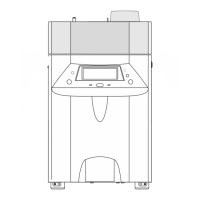Routine Maintenance: Inlets
Maintaining a purged packed inlet
Released: March 2004 6850 Series II GC User Information page 144 of 256
Leak testing the gas plumbing
Leaks in the gas plumbing system can affect chromatographic results dramati-
cally. The following procedure checks the flow system up to but not including
the inlet flow manifold. If this portion of the system proves to be leak-free,
refer to the next procedure to check the inlet and inlet manifold.
Caution Liquid leak detectors are not recommended, especially in areas where
cleanliness is very important. If you do use leak detection fluid, immediately
rinse the fluid off to remove the soapy film.
Tools:
• Electronic leak detector or liquid leak detection fluid. If you use leak
detection fluid, wipe off excess fluid when you have completed the test.
• Two 7/16-inch wrenches
Procedure
Warning To avoid a potential shock hazard when using liquid detection fluid, turn the
GC off and disconnect the main power cord. Be careful not to spill leak
solution on electrical leads, especially the detector and inlet heater leads.
1. Using the leak detector, check each connection you have made for leaks.
2. Correct leaks by tightening the connections. Retest the connections; con-
tinue tightening until all connections are leak-free.
Leak testing a purged packed inlet
This procedure allows you to determine if the inlet is leaking. It is
recommended that you leak test the inlet at your normal operating temperature
since the O-ring may leak if it is cooled to ambient.
If you have access to a Control Module, you can perform this test
automatically. See its documentation for details. The Control Module test
program will prompt you to complete the hardware tasks outlined below.
Materials needed:
• Gloves (if the inlet is hot)
• Septum nut wrench (part no. 19251-00100)
•Clock or watch
• 1/8-inch brass nut, 5180-4103
• 1/8-inch Vespel/graphite blank ferrule, 0100-1372

